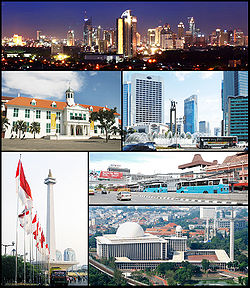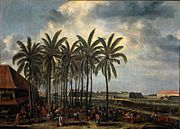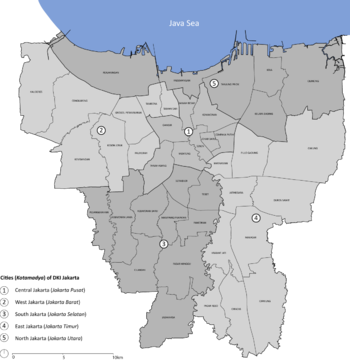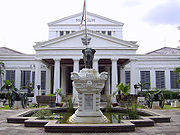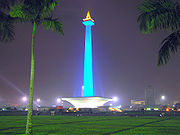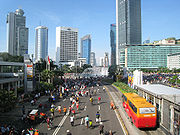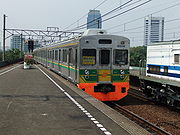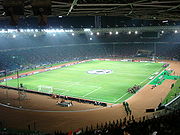
Jakarta
Background to the schools Wikipedia
SOS Children volunteers helped choose articles and made other curriculum material Child sponsorship helps children one by one http://www.sponsor-a-child.org.uk/.
| Jakarta Daerah Khusus Ibukota Jakarta |
|||
|---|---|---|---|
| Special Capital Territory of Jakarta | |||
| (From top, left to right): Jakarta Skyline, Jakarta Old Town, Hotel Indonesia Roundabout, Monumen Nasional, Jakarta traffic, Istiqlal Mosque | |||
|
|||
| Nickname(s): The Big Durian | |||
| Motto: Jaya Raya (Indonesian) (Victorious and Great) |
|||
|
|
|||
| Coordinates: 6°12′S 106°48′E Coordinates: 6°12′S 106°48′E | |||
| Country | Indonesia | ||
| Province | Jakarta | ||
| Government | |||
| • Type | Special administrative area | ||
| • Governor | Fauzi Bowo | ||
| Area | |||
| • City | 740.28 km2 (285.82 sq mi) | ||
| • Land | 662.33 km2 (255.73 sq mi) | ||
| • Water | 6,977.5 km2 (2,694.0 sq mi) | ||
| Elevation | 7 m (23 ft) | ||
| Population (2010) | 9,580,000 | ||
| • City | 9,580,000 | ||
| • Density | 14,464.08/km2 (37,461.8/sq mi) | ||
| • Metro | 26,600,000 | ||
| Time zone | WIB ( UTC+7) | ||
| Area code(s) | +62 21 | ||
| Website | www.jakarta.go.id (official site) Enjoy Jakarta (tourism site) | ||
Jakarta (English pronunciation: /dʒəˈkɑrtə/; Indonesian: /dʒakarta/), officially the Special Capital Territory of Jakarta, is the capital and largest city of Indonesia. Located on the northwest coast of Java, it has an area of 661 square kilometres (255 sq mi) and a 2010 census count population of 9,580,000. Jakarta is the country's economic, cultural and political centre. It is the most populous city in Indonesia and in Southeast Asia, and is the twelfth-largest city in the world. The urban area, Jabodetabek, is the second largest in the world. Jakarta is listed as a global city in the 2008 Globalization and World Cities Study Group and Network (GaWC) research. The city's name is derived from the Old Javanese word "Jayakarta" which translates as "victorious deed", "complete act", or "complete victory".
Established in the fourth century, the city became an important trading port for the Kingdom of Sunda. It grew as the capital of the colonial Dutch East Indies. It was made capital of Indonesia when the country became independent after World War II. It was formerly known as Sunda Kelapa (397–1527), Jayakarta (1527–1619), Batavia (1619–1942), and Djakarta (1942–1972).
Landmarks include the National Monument and Istiqlal Mosque. The city is the seat of the ASEAN Secretariat. Jakarta is served by the Soekarno-Hatta International Airport, Halim Perdanakusuma International Airport, and Tanjung Priok Harbour; it is connected by several intercity and commuter railways, and served by several bus lines running on reserved busways.
History
Pre-colonial era
The Jakarta area was part of the fourth century Hindu Sundanese Kingdom of Tarumanagara. Following the decline of Tarumanagara, its territories, including the Jakarta area, became part of the Kingdom of Sunda. The harbour area became known as Sunda Kelapa and by the fourteenth century, it was a major trading port for the kingdom. The first European fleet, four Portuguese ships from Malacca, arrived in 1513 when the Portuguese were looking for a route for spices. The Kingdom of Sunda made a peace agreement with Portugal by allowing the Portuguese to build a port in 1522 in order to defend against the rising power of the Sultanate of Demak from central Java. In 1527, Fatahillah, a Sumatran Malay warrior from Demak attacked and conquered Sunda Kelapa, driving out the Portuguese. Sunda Kelapa was renamed Jayakarta, and became a fiefdom of the Sultanate of Banten which became a major Southeast Asia trading centre.
Through the relationship with Prince Jayawikarta from the Sultanate of Banten, Dutch ships arrived in Jayakarta in 1596. In 1602, the British East India Company's first voyage, commanded by Sir James Lancaster, arrived in Aceh and sailed on to Banten where they were allowed to build a trading post. This site became the centre of British trade in Indonesia until 1682.
Jayawikarta is thought to have made trading connections with the English merchants, rivals of the Dutch, by allowing them to build houses directly across from the Dutch buildings in 1615.
Colonial era
When relations between Prince Jayawikarta and the Dutch deteriorated, Jayawikarta's soldiers attacked the Dutch fortress. Prince Jayakarta's army and the British were defeated by the Dutch, in part owing to the timely arrival of Jan Pieterszoon Coen (J.P. Coen). The Dutch burned the English fort, and forced the English to retreat on their ships. The victory consolidated Dutch power and in 1619 they renamed the city "Batavia."
Commercial opportunities in the capital of the Dutch colony attracted Indonesian and especially Chinese immigrants, the increasing numbers creating burdens on the city. Tensions grew as the colonial government tried to restrict Chinese migration through deportations. On 9 October 1740, 5,000 Chinese were massacred and the following year, Chinese inhabitants were moved to Glodok outside the city walls. The city began to move further south as epidemics in 1835 and 1870 encouraged more people to move far south of the port. The Koningsplein, now Merdeka Square was completed in 1818, the housing park of Menteng was started in 1913, and Kebayoran Baru was the last Dutch-built residential area. By 1930 Batavia had more than 500,000 inhabitants, including 37,067 Europeans.
The Japanese renamed the city "Jakarta" during their World War II occupation of Indonesia.
Independence era
Following World War II, Indonesian Republicans withdrew from Allied-occupied Jakarta during their fight for Indonesian independence and established their capital in Yogyakarta. In 1950, once independence was secured, Jakarta was once again made the national capital. Indonesia's founding president, Sukarno, envisaged Jakarta as a great international city, and instigated large government-funded projects with openly nationalistic and modernist architecture. Projects included a clover-leaf highway, a major boulevard (Jalan MH Thamrin-Sudirman), monuments such as The National Monument, Hotel Indonesia, a shopping centre, and a new parliament building. In October 1965, Jakarta was the site of an abortive coup attempt in which 6 top generals were killed, precipitating a violent anti-communist purge in which half-a million were killed, and the beginning the beginning of Suharto's New Order. A monument stands where the generals' bodies were dumped.
In 1966, Jakarta was declared a "special capital city district" (daerah khusus ibukota), thus gaining a status approximately equivalent to that of a state or province. Lieutenant General Ali Sadikin served as Governor from the mid-60's commencement of the " New Order" through to 1977; he rehabilitated roads and bridges, encouraged the arts, built several hospitals, and a large number of new schools. He also cleared out slum dwellers for new development projects—some for the benefit of the Suharto family—and tried to eliminate rickshaws and ban street vendors. He began control of migration to the city in order to stem the overcrowding and poverty. Foreign investment contributed to a real estate boom which changed the face of the city.
The boom ended with the 1997/98 East Asian Economic crisis putting Jakarta at the centre of violence, protest, and political maneuvering. After 32 years in power support from President Suharto began to wane. Tensions reached a peak in when four students were shot dead at Trisakti University by security forces; four days of riots and violence ensued that killed an estimated 1,200, and destroyed or damaged 6,000 buildings. Much of the rioting targeted Chinese Indonesians. Suharto resigned as president, and Jakarta has remained the focal point of democratic change in Indonesia. Jemaah Islamiah-connected bombings occurred almost annually in the city between 2000 and 2005, with another bombing in 2009.
Administration
Kota or kotamadya (cities) of Jakarta
Officially, Jakarta is not a city, but a province with special status as the capital of Indonesia. It has a governor (instead of a mayor), and is divided into several sub-regions with their own administrative systems. As a province, the official name of Jakarta is Daerah Khusus Ibukota Jakarta ("Special Capital City District of Jakarta"), which in Indonesian is abbreviated to DKI Jakarta.
Jakarta is divided into five kota or kotamadya ("cities" - formerly municipalities), each headed by a mayor, and one regency (kabupaten) headed by a regent. In August 2007, Jakarta held its first ever election to choose a governor, whereas previously the city's governors were appointed by local parliament. The poll is part of a country-wide decentralization drive, allowing for direct local elections in several areas.
The cities/municipalities of Jakarta are:
- Central Jakarta (Jakarta Pusat, formerly 'Weltevreden') is Jakarta's smallest city and home to most of Jakarta's administrative and political centre. It is characterized by large parks and Dutch colonial buildings. Landmarks include the National Monument ( Monas), the Istiqlal Mosque, and museums.
- West Jakarta (Jakarta Barat) has the highest concentration of small-scale industries in Jakarta. The area includes Jakarta's Chinatown and landmarks include the Chinese Langgam building and the Toko Merah building. West Jakarta contains part of the Jakarta Old Town.
- South Jakarta (Jakarta Selatan), originally planned as a satellite city, is now the location of large upscale shopping centers and affluent residential areas. Jakarta Selatan functions as Jakarta's ground water buffer, but recently the green belt areas are threatened by new developments. Much of the CBD area of Jakarta is concentrated in Setia Budi, South Jakarta, bordering the Tanah Abang/Sudirman area of Central Jakarta.
- East Jakarta (Jakarta Timur) territory is characterized by several industrial sectors erected in this city. There is also still some area of swamps and rice fields in this city.
- North Jakarta (Jakarta Utara) is the only city in Jakarta that is bounded by the sea ( Java Sea). It is the location of the Tanjung Priok Port. Big-scale and medium-scale industries are concentrated in North Jakarta. North Jakarta contains the location of Jakarta Old Town, formerly known as Batavia since the 17th century, and was a centre of VOC trade activity in Dutch East Indies. Also located in North Jakarta is Ancol Dreamland ( Taman Impian Jaya Ancol), currently the largest integrated tourism area in South East Asia.
The only regency (kabupaten) of Jakarta is:
- Thousand Islands (Kepulauan Seribu), formerly a subdistrict of North Jakarta, is a collection of 105 small islands located on Java Sea. It has a high conservation value because of its unique and special ecosystems. Marine tourism, such as diving, water bicycle, and wind surfing, is the most important touristic activity in this territory. The main transportation between these islands are speed boat or small ferries.
| City/Regency | Area (km2) | Total population (registered)(2007) | Total population (2007) | Population Density (km2) |
|---|---|---|---|---|
| South Jakarta | 141.27 | 1,730,680 | 2,100,930 | 14,872 |
| East Jakarta | 188.03 | 2,159,785 | 2,421,419 | 12,878 |
| Central Jakarta | 48.13 | 880,286 | 889,680 | 18,485 |
| West Jakarta | 129.54 | 1,562,837 | 2,172,878 | 16,774 |
| North Jakarta | 146.66 | 1,200,958 | 1,453,106 | 9,908 |
| Thousand Islands | 8.7 | 19,915 | 19,980 | 2,297 |
Government
In September 1945, the government of Jakarta City was changed from the Japanese Djakarta Toku-Betsu Shi into the Jakarta National Administration. This first government was held by a Mayor until the end of 1960 when the office was changed to that of a Governor. The last mayor of Jakarta was Sudiro, until he was replaced by Dr Sumarno as Governor.
In 1974, Based on the Act No. 5 of 1974 relating to the Fundamentals of Regional Government, Jakarta was confirmed as the capital city of Indonesia and one of Indonesia's 26 provinces.
Geography and climate
Geography
Jakarta is located on the northwest coast of Java, at the mouth of the Ciliwung River on Jakarta Bay, which is an inlet of the Java Sea. Officially, the area of the Jakarta Special District is 662 km2 of land area and 6,977 km2 of sea area. Jakarta lies in a low, flat basin, averaging 7 metres (23 feet) above sea level; 40% of Jakarta, particularly the northern areas, is below sea level, while the southern parts are comparatively hilly. Rivers flow from the Puncak highlands to the south of the city, across the city northwards towards the Java Sea; the most important is the Ciliwung River, which divides the city into the western and eastern principalities. Other rivers include the Pesanggrahan, and Sunter.
These rivers, combined with Jakarta's low topography make it prone to flooding from swollen rivers in the wet season and high sea tides. Other contributing factors include clogged sewage pipes and waterways that service an increasing population, in addition to deforestation near rapidly urbanizing Bogor and Depok in Jakarta's hinterland. Furthermore, Jakarta is an urban area with complex socio-economic problems that indirectly contribute to triggering a flood event. Major floods occurred in 1996 when 5,000 hectares of land were flooded and 2007. Losses from infrastructure damage and state revenue were at least 5.2 trillion rupiah (572 million US dollars) and at least 85 people were killed and about 350,000 people forced from their homes. Approximately 70% of Jakarta's total area was flooded with water up to four meters deep in parts of the city.
The Thousand Islands, which are administratively a part of Jakarta, are located in Jakarta Bay north of the city.
Climate
Jakarta has a hot and humid tropical wet and dry climate (Aw) according to the Köppen climate classification system. Despite being located relatively close to the equator, the city has distinct wet and dry seasons. Wet seasons in Jakarta cover the majority of the year, running from November through June. The remaining four months forms the city’s dry season. Located in the western-part of Indonesia, Jakarta's wet season rainfall peak is January with average monthly rainfall of 385 millimetres (15.2 in), and its dry season low point is July with a monthly average of 31 millimetres (1.2 in).
| Climate data for Jakarta | |||||||||||||
|---|---|---|---|---|---|---|---|---|---|---|---|---|---|
| Month | Jan | Feb | Mar | Apr | May | Jun | Jul | Aug | Sep | Oct | Nov | Dec | Year |
| Average high °C (°F) | 29.9 (85.8) |
30.3 (86.5) |
31.5 (88.7) |
32.5 (90.5) |
32.5 (90.5) |
31.4 (88.5) |
32.3 (90.1) |
32 (89.6) |
33 (91.4) |
32.7 (90.9) |
31.3 (88.3) |
32 (89.6) |
31.8 (89.2) |
| Average low °C (°F) | 24.2 (75.6) |
24.3 (75.7) |
25.2 (77.4) |
25.1 (77.2) |
25.4 (77.7) |
24.8 (76.6) |
25.1 (77.2) |
24.9 (76.8) |
25.5 (77.9) |
25.5 (77.9) |
24.9 (76.8) |
24.9 (76.8) |
25 (77) |
| Precipitation mm (inches) | 384.7 (15.146) |
309.8 (12.197) |
100.3 (3.949) |
257.8 (10.15) |
133.4 (5.252) |
83.1 (3.272) |
30.8 (1.213) |
34.2 (1.346) |
29 (1.14) |
33.1 (1.303) |
175 (6.89) |
84 (3.31) |
1655.2 (65.165) |
| Avg. rainy days | 26 | 20 | 15 | 18 | 13 | 17 | 5 | 24 | 6 | 9 | 22 | 12 | 187 |
| Source: World Meteorological Organisation | |||||||||||||
Culture
As the economic and political capital of Indonesia, Jakarta attracts many domestic immigrants who bring their various languages, dialects, foods and customs.
The Betawi (Orang Betawi, or "people of Batavia") is a term used to describe the descendants of the people living in and around Batavia and recognized as an ethnic group from around the 18th-19th century. The Betawi people are mostly descended from various Southeast Asian ethnic groups brought or attracted to Batavia to meet labor needs, and include people from different parts of Indonesia. The language and Betawi culture are distinct from those of the Sundanese or Javanese. The language is mostly based on the East Malay dialect and enriched by loan words from Dutch, Portuguese, Sundanese, Javanese, Chinese, and Arabic. Nowadays, the Jakarta dialect (Bahasa Jakarta) used as a street language by people in Jakarta is loosely based on the Betawi language.
Betawi arts are rarely found in Jakarta due to their low profile and most Betawi have moved to the border of Jakarta, displaced by new immigrants. It is easier to find Java or Minang based wedding ceremonial instead of Betawi weddings in Jakarta. It is easier to find Javanese Gamelan instead of Gambang Kromong (a mixture between Betawi and Chinese music) or Tanjidor (a mixture between Betawi and Portuguese music) or Marawis (a mixture between Betawi and Yaman music). However, some festivals such as the Jalan Jaksa Festival or Kemang Festival include efforts to preserve Betawi arts by inviting artists to give performances.
There has also been a Chinese community in Jakarta for many centuries. Officially, they make up 6% of the Jakarta population, though this number may be under-reported.
Jakarta has several performing art centers, such as the Taman Ismail Marzuki (TIM) art centre in Cikini, Gedung Kesenian Jakarta near Pasar Baru, Balai Sarbini in Plaza Semanggi area, Bentara Budaya Jakarta in Palmerah area, Pasar Seni (Art Market) in Ancol, and traditional Indonesian art performances at the pavilions of some Provinces in Taman Mini Indonesia Indah. Traditional music is often found at high-class hotels, including Wayang and Gamelan performances. Javanese Wayang Orang performance can be found at Wayang Orang Bharata theatre near Senen bus terminal. As the nation's largest city and capital, Jakarta has lured much national and regional talent who hope to find a greater audience and more opportunities for success.
Jakarta is hosting several prestigious art and culture festivals as well as exhibitions, such as the annual Jakarta International Film Festival (JiFFest), Jakarta International Java Jazz Festival, Jakarta Fashion Week, Jakarta Fashion & Food Festival (JFFF), Flona Jakarta (Flora and Fauna exhibition, held annually on August in Lapangan Banteng park featuring flowers, plant nursery, and pets), also Indonesia Creative Products and Jakarta Arts and Crafts exhibition. The Jakarta Fair is held annually from mid June to mid July to celebrate the anniversary of the city. It is largely centered around a trade fair, however this month-long fair also has featured entertainments, arts and music performances by local bands and musicians.
Several foreign art and culture centers also established in Jakarta, mainly serve to promote culture and language through learning centers, libraries, and art galleries. Among these foreign art and cultural centers are Netherlands Erasmus Huis, UK British Council, France Centre Culturel Français, Germany Goethe-Institut, Japan Foundation, and Jawaharlal Nehru Indian Cultural Centre.
Museums
The museums in Jakarta cluster around the Central Jakarta Merdeka Square area, Jakarta Old Town, and Taman Mini Indonesia Indah.
The Jakarta Old Town contains museums that are former institution buildings of Colonial Batavia. Some of these museums are Jakarta History Museum (former City Hall of Batavia), Wayang Museum (former Church of Batavia), the Fine Art and Ceramic Museum (former Court House of Justice of Batavia), Maritime Museum (former Sunda Kelapa warehouse), Bank Indonesia Museum (former Javasche Bank), and Bank Mandiri Museum (former Nederlandsche Handels Maatschappij).
Several museums that are clustered in central Jakarta around the Merdeka Square area are National Museum of Indonesia also known as Gedung Gajah means Elephant Building due to there are an elephant statue in front of the building, Monas (National Monument), Istiqlal Islamic Museum in Istiqlal mosque, and Jakarta Cathedral Museum on second floor of Jakarta Cathedral. Also in central Jakarta area the Taman Prasasti Museum (former cemetery of Batavia), and Textile Museum in Tanah Abang area.
The recreational area of Taman Mini Indonesia Indah in East Jakarta contains fourteen museums such as Indonesia Museum, Purna Bhakti Pertiwi Museum, Asmat Museum, Bayt al-Qur'an Islamic Museum, Pusaka (heirloom) Museum, and other science-based museum such as Research & Technology Information Centre, Komodo Indonesian Fauna Museum, Insect Museum, Petrol and Gas Museum, also Transportation Museum.
Other museums are Satria Mandala Military Museum, Museum Sumpah Pemuda, and Lubang Buaya.
Cuisine
Jakarta has a vast range of food available at hundreds of eating complexes located all over the city. From the modest street-side foodstalls and traveling vendors to the high-class expensive restaurants. The traditional Padang restaurants and humble budget Javanese Warteg (Warung Tegal) foodstalls is ubiquitous in the capital. Next to myriad selections of Indonesian food and regional specialities from all over Indonesia, there is also international food, especially Chinese, Japanese, Korean, Thai, Indian, American, French, Middle Eastern, to modern fusion food because of the cosmopolitan population. One of the popular local cuisine of Jakarta is Soto betawi, which is a cow milk or coconut milk broth with beef tendons, intestines, tripe. The other popular cuisine are kerak telor, gado-gado, sate, and kue cucur.
Economy, governance and infrastructure
Jakarta's economy depends heavily on financial service, trade, and manufacturing. Industry includes electronics, automotive, chemicals, mechanical engineering and biomedical sciences manufacturing. In 2009, 13% of the population had an income per capita in excess of US$ 10,000 (Rp 108,000,000).
The economic growth of Jakarta in 2007 was 6.44% up from 5.95% the previous year, with the growth in the transportation and communication (15.25%), construction (7.81%) and trade, hotel and restaurant sectors (6.88%). In 2007, GRP (Growth Regional Domestic Product) was Rp. 566.45 trillion. The largest contributions to GDRP was by finance, ownership and business services (28.7%); trade, hotel and restaurant sector (20.4%), and manufacturing industry sector (15.97%). In 2007, per capita GRDP of DKI Jakarta inhabitants was an 11.63% compared to previous year
Both GRDP by at current market price and GRDP by at 2000 constant price in 2007 for Municipality of Central Jakarta (Jakarta Pusat) is higher than other municipalities in DKI Jakarta, which is 145.81 million rupiahs and 80.78 million rupiahs.
A new law in 2007 forbids the giving of money to beggars, buskers and hawkers, bans squatter settlements on river banks and highways, and prohibits spitting and smoking on public transportation. Unauthorized people cleaning car windscreens and taking tips for directing traffic at intersections will also be penalized. Critics of the new legislation claim that such laws will be difficult to enforce and it tends to ignore the desperate poverty of many of the capital's inhabitants.
Surveys show that "less than a quarter of the population is fully served by improved water sources. The rest rely on a variety of sources, including rivers, lakes and private water vendors. Some 7.2 million people are without clean water."
In Kelurahan Penjaringan, one of Jakarta's largest slums, clean drinking water is in limited supply. Diseases such as malaria, dengue fever, cholera and acute respiratory infection are on the rise because of contaminated water.
Demography
The 2010 census counted some 9.58 million people, well above all government estimates. The area of DKI Jakarta is 662.33 km2, suggesting a population density of 14,464 people/km2. Inwards immigration tended to negate the effect of family planning programs. The population has risen from 1.2 million in 1960 to 8.8 million in 2004, counting only its legal residents. The population of greater Jakarta ( Jabodetabek Region) is 27,067,133 (2010 Census). By 2025 the population of Jakarta may reach 24.9 million, not counting millions more in surrounding areas.
Tourism and landmarks
Jakarta is primarily a city of government and business. It is seldom viewed as a centre for tourism other than the old part of the city which is a popular tourist destination. However the Jakarta authority saw the opportunity to develop the city's reputation as a service and tourism city. There are many new tourism infrastructures, entertainment centers, and international-class hotels and restaurants being built in Jakarta. Jakarta also possesses many historical places and cultural heritage.
The National Monument, stands at the centre of Merdeka Square, the central park of the city. Near the national monument stands a Mahabharata themed Arjuna Wijaya chariot statue and fountain. Further south through Jalan Thamrin, the main avenue of Jakarta, the "Selamat Datang" (welcome) statue stands on the fountain in the centre of Hotel Indonesia roundabout. Other landmarks include the Istiqlal Mosque, the Jakarta Cathedral, and the West Irian Liberation monument. The Wisma 46 building in Central Jakarta is currently the highest building in Jakarta and Indonesia. Tourist attractions include Taman Mini Indonesia Indah, Ragunan Zoo, Jakarta Old Town, and the Ancol Dreamland complex on Jakarta Bay, including Dunia Fantasi theme park, Sea World, Atlantis Water Adventure, and Gelanggang Samudra.
Most of the visitors attracted to Jakarta are domestic tourists from all over Indonesia, the majority of them from the neighboring provinces of West Java, Banten, Lampung, and Central Java. As the gateway of Indonesia, Jakarta often serves as the stop-over for foreign visitors on their way to Indonesian popular tourist destinations such as Bali and Yogyakarta. Most foreign visitors from the neighboring ASEAN countries; such as Malaysia and Singapore, visit Jakarta (to some extent also include Bandung) for shopping purposes, since the city is famous for its cheap but fair quality products, especially textiles, craft and fashion products.
Jakarta is sprawling with numerous malls, shopping centers, and traditional markets. Jakarta shopping malls with areas in excess of 100,000 metres square, include Grand Indonesia, Pacific Place Jakarta, Plaza Indonesia and Plaza e'X, Senayan City, Plaza Senayan, Pasaraya, Pondok Indah Mall, Mal Taman Anggrek, Mal Kelapa Gading, Mal Artha Gading, and Mall of Indonesia. Other smaller but popular malls are Sarinah Thamrin, Ratu Plaza, Atrium Senen, Mall Ambassador and Pasar Festival. Traditional markets include Blok M, Tanah Abang, Senen, Pasar Baru, Glodok, Mangga Dua, Cempaka Mas, and Jatinegara.
Parks
Taman Suropati is located in Menteng garden city subdistrict, Central Jakarta. The park is surrounded by several Dutch colonial buildings. Taman Suropati was known as Burgemeester Bishopplein during the Dutch colonial time. The park is circular shaped with a surface area of 16,322 m2. There are several modern statues in the park made by artists of the ASEAN countries, which contributes to the other nickname of the park "Taman persahabatan seniman ASEAN" ("Park of the ASEAN artists friendship"). Still located in Menteng area are the parks Taman Menteng and Situ Lembang pond. The Taman Menteng was built on the former Persija soccer Stadium.
Taman Lapangan Banteng (Buffalo Field Park) is located in Central Jakarta near Istiqlal Mosque, Jakarta Cathedral, and Jakarta Central Post Office. It is about 4,5 hectares. Initially it was called Waterlooplein of Batavia and functioned as the ceremonial square during Netherlands Indies. Many of the colonial monuments and memorials erected on the square were demolished during Sukarno era which later built the present monument in the square. The most notable landmark inside the park is the Monumen Pembebasan Irian Barat (Monument of the Liberation of Irian Barat). During the 1980s, the park is used as a bus terminal. In 1993, the park turned into a public space again and has become a recreation place for people and occasionally also used as an exhibition place or other events. The Jakarta Flona (Flora dan Fauna), the flower and decoration plants also pet exhibition is held in this park around August annually.
Taman Monas (Monas Park) or Taman Medan Merdeka (Medan Merdeka Park) is the park where the symbol of Jakarta, Monas or Monumen Nasional (National Monument) is located. The large open space was created by Dutch Governor General Herman Willem Daendels (1810) and was originally named Koningsplein (Kings Square). On 10 January 1993, President Soeharto initiate the action toward the beautification of the park. Several features in the park is a deer park and 33 trees that represents the 33 provinces of Indonesia.
Transportation
Jakarta is strained by transportation problems. The city still suffers a lack of urban public transport services due to the prioritised development of road networks, which mostly accommodate private vehicles. Most trips, however, are undertaken by non-motorized transportation (particularly walking) and numerous modes of public or demand-responsive transportation services.
| Transport mode | No. trips ('000) | % share |
|---|---|---|
| walking | 14,073 | 37.7 |
| small bus | 7,818 | 20.9 |
| motorcycle | 4,890 | 13.1 |
| sedang/kijang (SUV) | 2,783 | 7.5 |
| medium bus | 2,012 | 5.4 |
| large bus | 1,224 | 3.3 |
| ojek (motorcycle taxi) | 1,073 | 2.9 |
| bicycle | 787 | 2.1 |
| school/company bus | 466 | 1.2 |
| economy train | 434 | 1.2 |
| patas AC (bus) | 422 | 1.1 |
| colt/mini cab | 298 | 0.8 |
| omprengan | 295 | 0.8 |
| bajaj | 217 | 0.6 |
| becak | 202 | 0.5 |
| pick up | 131 | 0.4 |
| taxi | 126 | 0.3 |
| express train | 39 | 0.1 |
| truck | 33 | 0.1 |
| other | 8 | 0.0 |
| total | 37,330 | 100 |
Road transport
Jakarta suffers from traffic congestion. A 'three in one' rule during peak hour was introduced in 1992, prohibiting fewer than three passengers per car on Jakarta busiest avenues. This rule applies to Jalan MH Thamrin, Jalan Jenderal Sudirman, Jalan Majapahit, Jalan Gajah Mada and Hayam Wuruk, from 7:00 AM to 10:00 AM and from 4:00 PM to 7:00 PM.
"Auto rickshaws", called bajaj, provide local transportation in the back streets of some parts of the city. From the early 1940s to 1991 they were a common form of local transportation in the city.
In 1966, an estimated 160,000 pedicabs (becak) were operating in the city; as much as fifteen percent of Jakarta's total workforce was engaged in becak driving. In 1971, becak were banned from major roads, and shortly thereafter the government attempted a total ban, which substantially reduced their numbers but did not eliminate them. A campaign to eliminate them succeeded in 1990 and 1991, but during the economic crisis of 1998, some returned amid less effective government attempts to control them.
The TransJakarta bus rapid transit service (known as Busway) was developed in the context of development reform (or reformasi) and used Bogota's TransMilenio system as a model. Jakarta's first busway line, from Blok M to Jakarta Kota opened in January 2004 and as of December 31, 2010, ten corridors are in use. The city government planned to open all 15 corridors within a decade making the TransJakarta system one of the fastest deployed bus rapid transit systems in the world. However, new developments in the planned metro system have postponed the remaining five corridors.
A structured road network had been developed in the early 19th century as part of the Java Great Post Road by Daendels, connecting most major cities throughout Java. During the following decades, the road network was expanded to a great extent, although it could not keep up with the rapidly increasing numbers of motorized vehicles, resulting in today's traffic problems. Toll roads connect Jakarta to Soekarno-Hatta International Airport and to the ports of Merak and Tangerang to the west, Bogor and Puncak to the south, and Bekasi, Cikarang, Karawang, Cikampek, Purwakarta and Bandung to the east. The Jakarta inner ring road is a busy toll road circling Jakarta and connecting important centers and interchanges such as Semanggi near the Sudirman business centre; Cawang, Tomang and Pluit interchanges; the port of Tanjung Priok, and Soekarno-Hatta International Airport. An outer ring road is under construction, but it is largely operational.
Railway
Long-distance railways and local tram services were first introduced during the Dutch colonial era. While the trams were replaced with buses in the post-colonial era, long-distance railways continued to connect the city to its neighboring regions as well as cities throughout Java. The surrounding cities of Jakarta are served by KRL Jabotabek, a mass rapid transit system which serves commuters both in and around Jakarta. The major rail stations are Gambir, Jakarta Kota, Jatinegara, Pasar Senen, Manggarai, and Tanah Abang. During rush hours, the number of passengers greatly exceeds the system's capacity, and crowding is common.
There had been plans for a monorail and part of it was already under construction, but the project stalled in 2004 and was officially abandoned as of 2008, mostly due to a lack of investors to fund it all. If completed, the monorail would have been made up of two lines: the green line serving Semanggi-Casablanca Road-Kuningan-Semanggi and the blue line serving Kampung Melayu-Casablanca Road- Tanah Abang- Roxy.
A two-line metro (MRT) system is currently being developed, with a north-south line between Kota and Lebak Bulus, with connections to both monorail lines; and an east-west line, which will connect to the north-south line at Sawah Besar Station. In the end the JMRT will be a combination of both subways and elevated rails. The metro system will be built beginning in 2011 with a 15.2 km long line between Hotel Indonesia and Lebak Bulus, and the entire MRT network is scheduled to be operational by 2016. Because of this, the five remaining planned busways have been postponed.
Air
Soekarno-Hatta International Airport (CGK) is the main airport serving the greater Jakarta area. The airport is named after the first President of Indonesia, Soekarno, and the first vice-president, Mohammad Hatta. The airport is often called Cengkareng by Indonesians. The airport's IATA code, CGK, originates from the name of the Cengkareng locality, a district situated to the northwest of the city. It is Indonesia's busiest airport handling nearly 40 million passengers annually. A second airport, Halim Perdanakusuma International Airport (HLP) serves mostly private and VIP/presidential flights. Other airports in the Jabotabek metropolitan area include Pondok Cabe Airport and an airfield on Pulau Panjang, part of the Thousand Island archipelago.
Waterway
On 6 June 2007, the city administration introduced the Waterway, a new river boat service along the Ciliwung River.
Sea
Jakarta's main seaport Tanjung Priok serves many ferry connections to different parts of Indonesia.
Education
The biggest university in Jakarta is the University of Indonesia with campuses in Salemba and Depok. Other government universities include Jakarta State University, Jakarta State Polytechnic, and Jakarta Islamic State University. Nowadays, the oldest university is the privately owned Universitas Nasional (UNAS). Private universities in Jakarta include Trisakti University Atma Jaya University, and Tarumanagara University.
STOVIA was the first high school in Jakarta, established in 1851. As the largest city and the capital, Jakarta houses a large number of students from various parts of Indonesia, many of whom reside in dormitories or home-stay residences. For basic education, there are a variety of primary and secondary schools, tagged with public (national), private (national and bi-lingual national plus) and international schools. Two of the major international schools located in Jakarta are the Jakarta International School and the British International School (BIS). Other international schools include the Jakarta International Korean School, Jakarta International Multicultural School, Australian International School, New Zealand International School, Singapore International School and SPH International School
Sports
Jakarta was host to the Asian Games in 1962, host of the Asian Cup 2007, and has hosted the regional-scale Southeast Asian Games several times. Jakarta's most popular football club is Persija, which plays its matches in the Bung Karno Stadium or Lebak Bulus Stadium. Another premiere division team is Persitara which plays its matches in the Sumantri Brojonegoro Stadium.
The biggest stadium in Jakarta is the Bung Karno Stadium with a capacity of 88,083 seats. The Second stadium in Jakarta is the Sunter Main Asiad Stadium with a capacity of 99,093 seats. For basketball, the Kelapa Gading Sport Mall in Kelapa Gading, North Jakarta, with a capacity of 7,000 seats, is the home arena of the Indonesian national basketball team. The Senayan sports complex has several sport venues, including the Bung Karno soccer stadium, Madya Stadium, Istora Senayan, a shooting range, a tennis court and a golf driving range. The Senayan complex was built in 1959 to accommodate the Asian Games in 1962.
In 2011, Jakarta, together with Bandung, Surakarta, Semarang and Palembang will again host the Southeast Asian Games.
Twin towns and sister cities
Sister relationships with towns and regions worldwide include:
|
|
|
|
